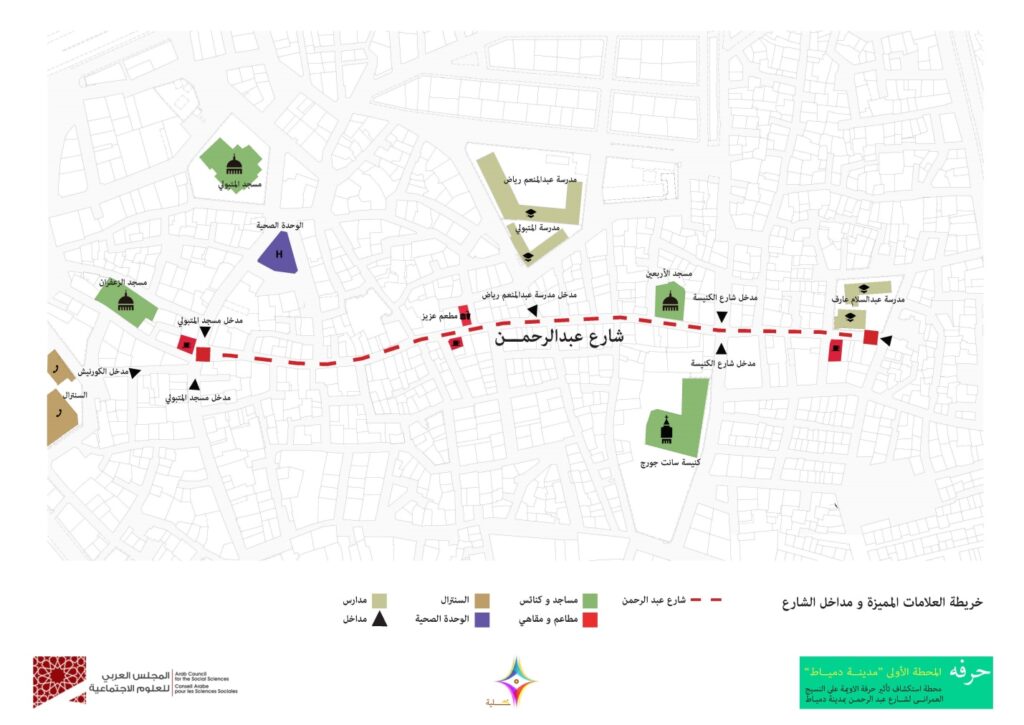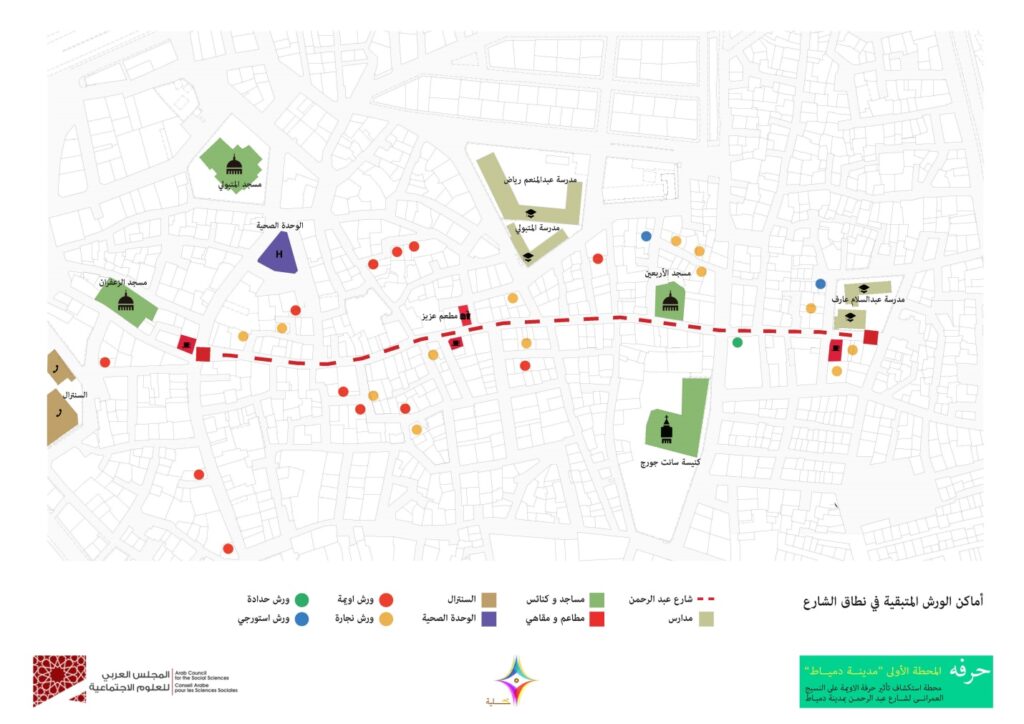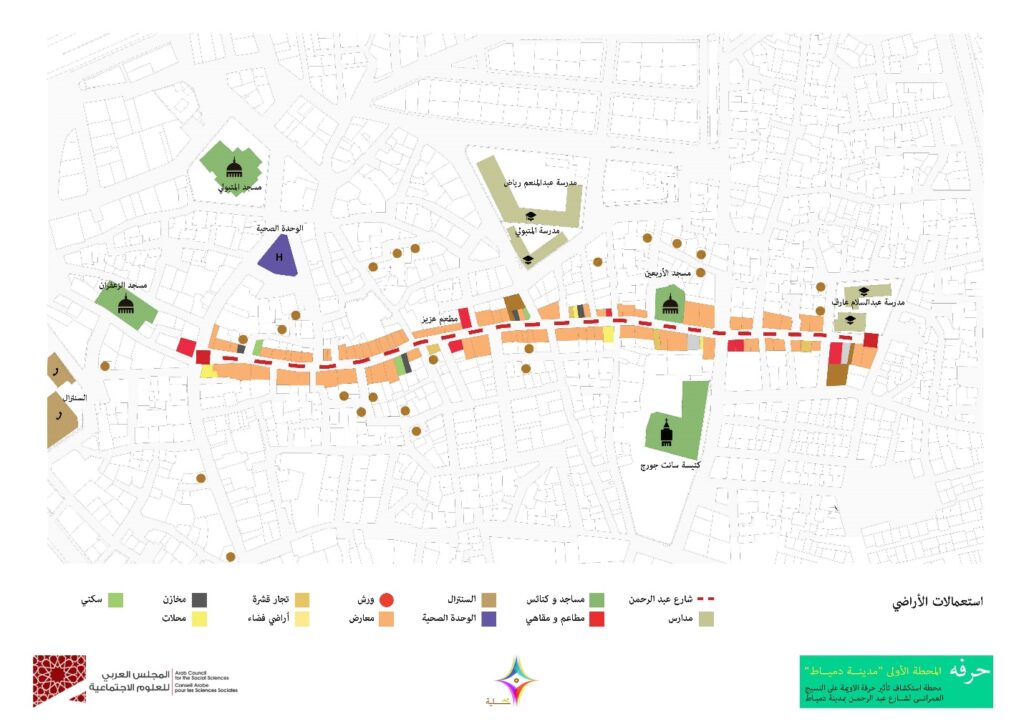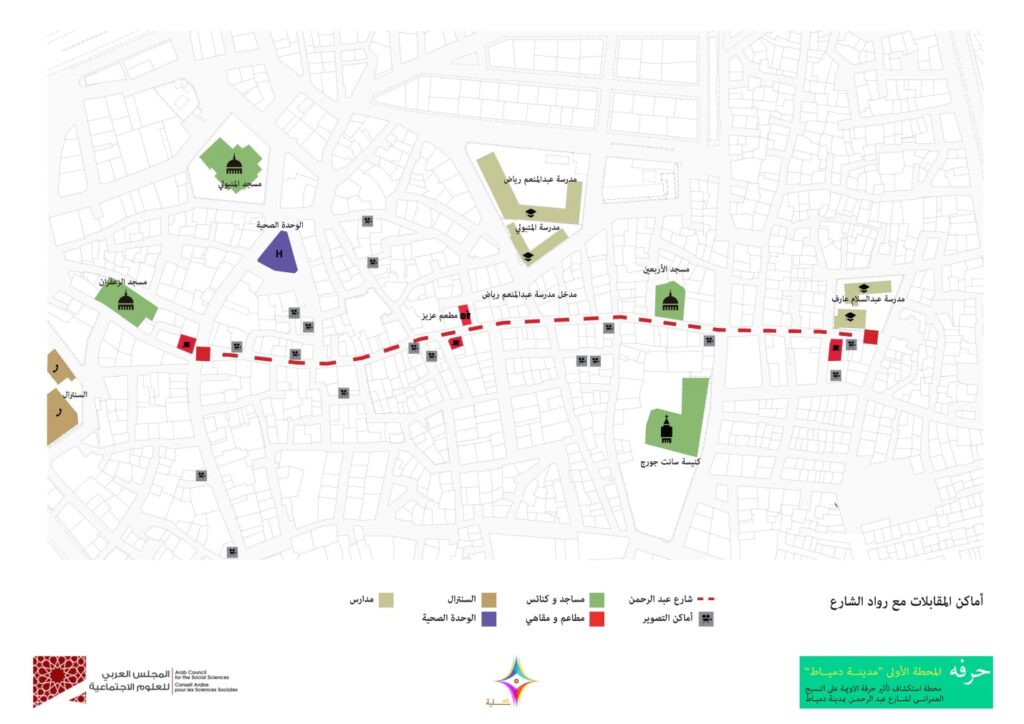O’yma is wood carving craft in Arabic.

A brief history of Damietta
The city of Damietta was the 17th province in the ancient Egyptian civilization. It was an important area for storing crops and grains. With time, and due to trade and close proximity; a strong network was established with the Greek in 325 AD.
When Muhammad Ali ruled Egypt in 1804, the city got more attention. A Cotton spinning and weaving factory was built making it an important trading center introducing many products in the city. However, after the First World War in 1914 the trade stopped and resources were cut off from abroad and Damietta began a further manufacturing to other products like shoes making, carpentry and loom weaving.
Abdulrahman street
After the construction of the high dam, many water ponds and wetlands dried in the area, including Al-Berkah (The bond) neighborhood, That Abdulrahman street lies in the middle of. In the city records the street was named Al-Madinah street. One of the craftsmen said the street was named Abdulrahman street recently after ‘Abdulrahman Al-Idrisi’ (One of Islam figures), while master Abdu Jado (another craftsman) told us that the are was full of trenches and water channels where a huge battle took place leaving behind 40 martyrs including one named ‘Abdulrahman’ whom was a descendants of AbuBakr (The closest friend to The prophet Muhammed peace be upon him). To glorify them, the mosque in the street was called Masjed Al-Arba’een (the 40s mosque) and the street was called Abdulrahman street. There are many tales why the street got its name from its residents, but they all agreed that it was mainly a manufacturing street for carpentry and wood carving, but it is becoming more of a commercial street to sell carpentry and wooden furniture.

Master Mahmoud (one of the craftsmen) tells us that the area was a network of trenches and water canals supporting the former story extending from Saint-George Church to Shehabiya neighbourhood. He tells us that the land was mostly dirt and not the asphalt that is currently there but in the main lanes closer to the Nile corniche, ‘English’ black tiles can be found (referring to cobblestone) deducing and telling us that the urban expansion started from the Nile side inwards.

Carpentry in Damietta
Master Mohamed tells the team that the Nile was the natural port -in front of the current tele-communication company adjacent to Al-Berkah neighbourhood- before the current Damietta port. Ships used to come from Al-Sham (The Levant) countries to park there vitalizing the area. The existing of the port there helped in promoting carpentry craft as it was need to maintain and serve the ships and boats. When the French came with their furniture and art pieces, they sought help from the artisans and craftsmen in their installation. In turn they learn from these pieces and were able to imitate it. That was one of the main reasons that they practice and learned the craft of making furniture and O’yma (wood carving) to decorate that furniture.

Initially, the O’yma flourished in the street, and many owners and residents with other occupations turned to the O’yma craft, furniture industry and opening workshops beneath their homes, an area was formed to produce integrated furniture production platform, and the street contained more than 100 small hand workshops between carpentry and O’yma.
The turn to O’yma and carpentry was motivated by yet other negative reasons. Master Mahmoud mentioned that by the time of constructing Cotton spinning and weaving factories in Helwan, lots of workers migrated outside of Damietta and from the small spinning and weaving workshops that was established after the first factory. That created an economic vacuum where carpentry and furniture were there to fill that vacuum. Many of the owners converted their workshops to Carpentry and O’yma.
The street was recognized around the world with its distinctive products, and the street had a highly competitive advantage with its integrated platform. However with this commercial momentum, many craftsmen began to turn workshops into exhibitions. The street turned into a brand and became crowded at all times and many shops left their activity and turned into exhibitions. One of the oldest craftsmen was telling us that one couldn’t step a foot within the crowd.
“I swear to Allah in the sky, that you couldn’t walk in the street even going sideways with your shoulder (from the crowds)”
An overview of O’yma craft through 50 years
Many craftsmen got to learn its practice within the street workshops. For example, Master Zaki’s workshop was staffed with more than 15 apprentices whom all were originally from outside of Damietta. The knowledge also transferred through families where many of the workshops owners passed on their knowledge, artistic skills and expertise to their children and ancestors. Some even send them to other workshops to learn new skills that can integrate with what they already have. The children and apprentices later grew to have their own workshops inside the street or in close proximity to it and to their families.
That is illustrated when Master Al-Saied came to the area and bought a piece of land that used to host a school. He built a four story apartment house (as an expression of wealth). It was the highest building in the street when his ancestor is telling us ” I used to see the Nile from my grandpa home”. When one of his children was becoming independent, he bought a land next door and build his own apartment building. When we wondered why in the same place -specially because at the time there was other tempting options-, he answered us ” whoever lived in Abdulrahman street cannot really live outside of it”. Probably that was a reflection on the social life that is well integrated and connected to its economy and dynamics. Al-A’haway (Coffeshops) were the places were most gathering happens in the street. Master Abdullah (a retired craftsman) tells us that Al-A’hwa is the main place to exchange knowledge and experiences to the craft. He mentioned that “Al-Galaa’ Casino” known as A’hwet Shalaby is the oldest coffeshop in the street.
The origin of O’yma from the perspective of craftsmen
O’yma is a craft related and connected to beauty. It is the ability, art and craftsmanship to convert a piece of wood to an artistic master piece. This master piece can be an addition or an installation on furniture pieces or it can be a standalone piece. One of the craftsmen was claiming that it is decoration in its core. “Decorate an ugly corn, it will become a bride”, he said. Another craftsman claimed it as art in its core. ” It depends on art, that is applied on wood”, he said. We Believe that the perception of it changes with the way each craftsman practice and belong to their craft. Woodcarving (O’yma) is an old art and craft from old ages. It evolved with each period to express its era.

The development of the craft
The fame of Damietta with O’yma craft began in the past century when O’yma workshops emerged and started to produce wooden parts, skeletons and furniture. Abdulrahman street popularity began in 1966 with The presence of the first 3 outlets from workshops to sell complete furniture sets per rooms (sleeping rooms furniture, dining rooms, etc…). Additional workshops and outlets were established and added over time creating a momentum that helped in increasing the street fame. It became popular on national and international level according to one of the craftsmen claim pointing out that the area visitors used to come from outside Egypt to the street specifically.
“(The street had) international reputation, not just in Egypt”

Urban and spaces morphologies
There is a noticeable and strong correlation between the craft, its practice, production and marketing patterns to the place and its form of dwelling. Initially O’yma began as small workshops beneath the residential places where the craftsman does his work and present/ sell it through the workshops. As business flourished and carpentry tools developed including big machinery, workshops needed bigger place for all logging, cutting and drilling machines. In addition, and as the street reputation increased and Al-Berkah neighborhood became a destination if anyone wants to buy furniture, spaces converted to be more commercial; Workshops were converted to furniture galleries expanding to take the whole ground floor in some cases, and in other cases some constructed additional floors to increase the gallery spaces to maximize their economic gain.

The urban fabric in terms of building plots and street boundaries had not change. The construction footprint is the same; in case of re-construction new buildings are constructed on the same area but with different heights. Two stories building became 6-7 stories height. However most of workshops were relocated somewhere else with the majority of spaces become commercial and gallery spaces to show-case furniture and O’yma products with only few remaining workshops. People in the street attributed this to: 1- Increasing renting prices in the street as it became commercial, that made it harder from craftspeople to afford the rents with the current stagnation forcing them to move to places in the peripheries; 2- Land owners prefer to make use of regulatory incentives to move their workshops to new places and use their properties as exhibition spaces; 3- Current stagnation pushed craftspeople to other jobs like driving a car, trade or something similar; 4- The introduction of CNC and machinery created an abundance of supply and reduced the role of craftsperson to do basic task like sanding, flattening, or basic preparations eliminating the need for large number of craftspeople; 5- In addition, exhibition owners prefer for their children to become highly-educated persons instead of being craftspeople.


Contradicting and divergent perspectives
The introduction of CNC and machinery negatively affected the O’yma craft, and this effect is multiplied when combined with inflation and the floating of Egyptian pound that negatively affected the furniture production and manufacturing business in general. People had different views and coping mechanism with the new reality. Some did not oppose the entry and integration of CNC and machinery and integrated them into their production process whilst adding their handcraft touch in the end of the process and whenever its possible, while attributing the stagnation to prices inflation to because of machineries.
“Wood was 4 EGP per kilo meaning the ton was 400 EGP, now the ton is 10,000 EGP!!!”
“Al-O’ymagy (craftsman) did not close because of machines, machines helps us and makes things easier”
While others see the cons and disadvantages of CNC is more than its pros and advantages. The sales rates are reduced for the craftspeople, and buyers shifted away from buying their products. claiming that the O’yma is done for because of CNC unless the art in O’yma prevails.
In plain words, The O’yma is done for because of CNC… but as god will, we will come back because a Damiettan is a true artist and will remain an artist”
Others had a total different perspective; they claimed that the customer who has a good taste appreciate O’yma and aims to buy it. On the other hand that customer who only cares about the price and the cheapest goes for the machines.
In conclusion, many economic factors affected the craft of O’yma (wood-carving) and wood/ furniture manufacturing in general. That is combined with prices inflation and difficulties to buy proper materials, many workshops are changing their activities.

All that is mentioned in the article is a documentation of stories and information from the owners of workshops and exhibitions within the premise of Abdulrahman Street in Damietta city during the preparation of a report on the team of the research craft project from 23-1-2018 until 28-1-2018.
The workshop team:
The team gathered from all over Egypt to participate in the workshop
Workshop Organizers:
- Yssmin Bayoumi
- Amr AlQamary
Consulting team:
- Hagar Mamdouh
- Mu’taz Mutawea
Mapping team:
- Ghada Abdel Aziz
- Noha Jamal
- Sarah Mohamed Taha
- Mohammed Hani Al-Hawari
- Amr Al-Qamary
Documentary team:
- Rawan Hamdy
- Hadeel Mahmoud
- Ahmed Mukhtar
Narrative and writing team:
- Amr Khaled
- Yssmin Bayoumi
Logistics team:
- Mohammed Tork
- Heba Hatem
- Ziad Al-Qashawy
